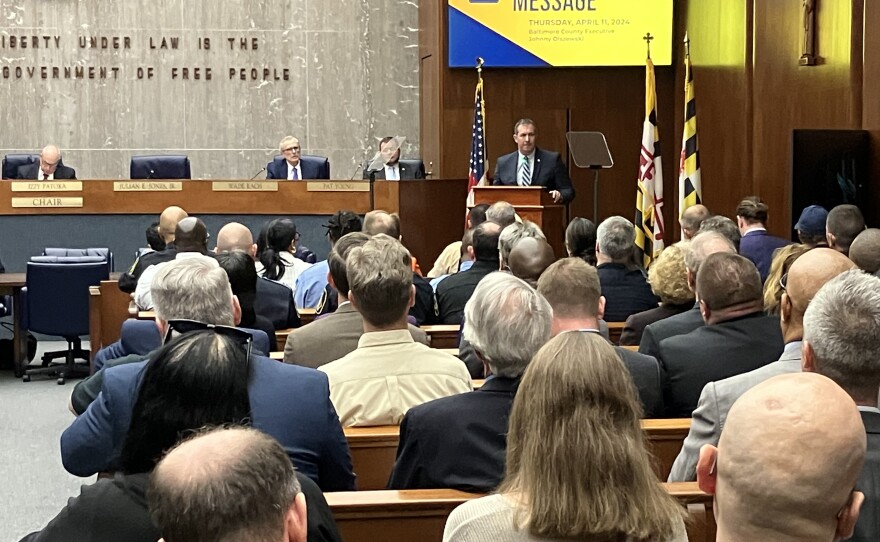Baltimore County Executive Johnny Olszewski Thursday warned the county needs to borrow hundreds of millions of dollars to meet basic needs, like new schools, police stations and firehouses.
While presenting his budget for the coming fiscal year that begins in July, Olszewski told the County Council that for decades the county failed to keep its buildings up to date. So in November, county voters will be asked to approve nearly $600 million in borrowing for future projects.
“We think voters should and will approve this borrowing,” Olszewski said. “But if they do, these funds must be paid back. Doing so will be difficult, if not impossible without significant new resources or significant reductions in county services in the years ahead.”
In an interview after his address, Olszewski said he did not consider raising taxes this year to help pay for the proposed borrowing. But Olszewski said he wants to be up front about the fiscal challenge the county is facing.
“Our fire department, our police department, our department of aging, our residents, all want, expect and are demanding these services,” Olszewski said. They’re expecting these investments.”
“These aren’t frivolous items that the county executive and probably the council will be asking the voters to support,” said Republican Councilman Todd Crandell. “It is a little disconcerting that the budget message included a warning to future county executives and future iterations of the council that we have tough times ahead.”
Democratic Councilman Mike Ertel agreed the need is there and that the county will have to figure out how to pay the bill.
“Nobody wants to hear, you know, my taxes are going to go up or fees are going to go up,” Ertel said. “But we’re going to have to look at how are we going to make all of this work.”
During his budget address, and with his voice at times cracking with emotion, Olszewski talked about the void the collapse of the Key Bridge has left. About mourning the loss of six lives. And he honored 13 first responders who were present in the packed council chambers and who have been part of the rescue and recovery.
“You are our heroes,” Olszewski said. “Thank you for all that you do.”
Olszewski’s proposed budget, which now goes to the County Council, includes more money for libraries. There is a cost of living raise for county employees, There is $1 million that will be used to establish the county’s fair election fund. Candidates will be able to apply for campaign finance money in the 2026 election.
During his budget address, Olszewski noted this could be the last one he delivers. He is running for Maryland’s Second Congressional District seat.
About half of Olszewski’s proposed $5 billion budget is going to education – and that’s where he says nearly half of the increased borrowing is going, too.
The budget invests $331 million in school infrastructure projects, and adopts the full $2.58 billion budget proposed by Superintendent Myriam Rogers in January – while adding $41 million over the state mandated minimum.
“This budget not only delivers on BCPS’ request, but goes even further to help deliver more bus drivers and more teachers to help reduce class sizes and give our children the attention they need and deserve to succeed throughout their educational careers,” Olszewski said during his speech Thursday.
Rogers said she’s “ecstatic” that the executive committed to a full investment, adding that it will be “wonderful for our students, wonderful for our entire Baltimore County school community.”
Olszewski also directed money to raise starting salaries for teachers to $60,000, up from $58,500 this past year – meeting the Blueprint for Maryland’s Future goal two years ahead of schedule.
“He has always put his money where his mouth is around education,” said Cindy Sexton, president of the Teachers’ Association of Baltimore County. “We still just need to work on all the other details that are causing our educators to leave the profession, like workload and class size.”
Superintendent Rogers’ original budget proposal reassigned staff from middle and high schools and boosted class sizes by around two seats to prioritize support for the county’s youngest learners.
Olszewski said he was able to keep elementary class sizes small and staffed, while also counteracting some of the necessary cuts Rogers made.
“Working with Superintendent Rogers, we put some of these positions back into the budget to help offset the transfers from middle school and high school, l and keep some of those teachers there,” he said. “So those class sizes are not going to be as impacted as originally envisioned.”
Olszewski’s budget also counteracts effects of state cuts to the Community College of Baltimore County, which total $4.5 million, by freezing tuition for the sixth year in a row.
“More than ever, our community colleges have been a launching pad for students of all ages who want to pursue their dreams in higher education,” he said.
The budget also maintains a free community college tuition program Olszewski started last year, which covers costs for Baltimore County families earning $150,000 per year or less.











